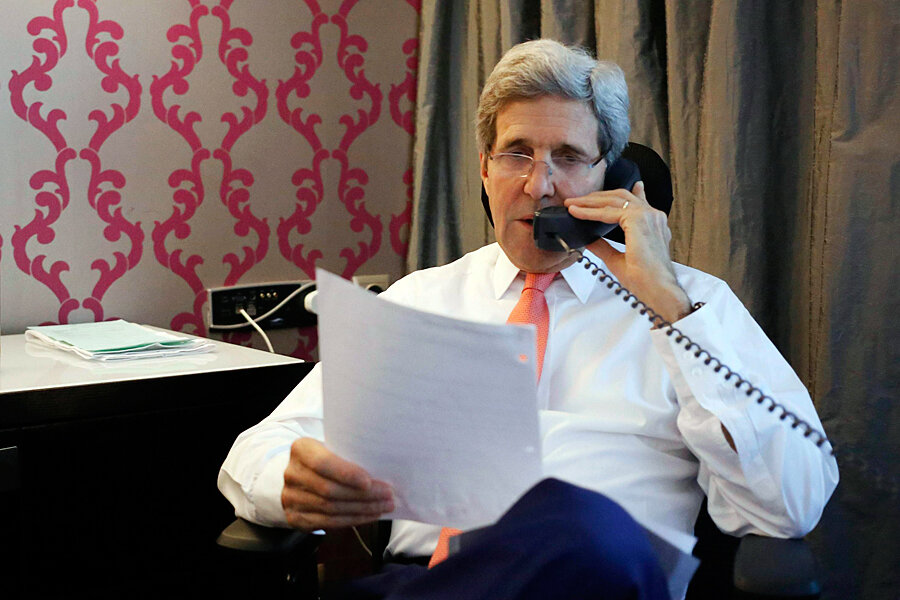Israel rejects Gaza cease-fire plan: what was in Kerry's proposal
Loading...
| Washington
A two-step plan involving a truce for at last five days and negotiations toward a more long-term settlement is how Secretary of State John Kerry envisions addressing the Gaza crisis.
But by Friday evening, after nearly four full days of shuttle diplomacy and nonstop phone calls, it appeared the chief US diplomat had fallen short with his plan for halting fighting that has left more than 800 mostly civilian Palestinians and 35 Israelis dead.
Still, Kerry planned to fly from Cairo to Paris for further talks Saturday on a cease-fire deal. "No one is stopping" this effort, he said in Cairo.
Israel’s security cabinet rejected Kerry’s plan as presented, and a spreading of violence Friday to the West Bank only dimmed the proposal’s prospects further. Qatari officials were discussing the plan with Hamas leadership based in their country. But Israeli demands for more favorable conditions before any plan could be accepted made it even more unlikely that Hamas would go along.
Still, a decision by the Israeli government to continue discussion to see how Kerry’s proposal might be made acceptable suggested that the bones of Kerry’s plan might yet serve for hammering out an agreement, even if not for the weekend as Kerry had hoped.
Kerry was scheduled to hold a press conference before departing Cairo Friday, but some details of the plan leaked out before he spoke.
First, both sides would agree to a suspension of hostilities of at least five days or up to a week, beginning Sunday, to allow for humanitarian assistance to Gaza’s besieged civilian population.
Second, Israel and Hamas would begin negotiations toward a more long-term settlement of the Gaza crisis during the truce, with Egypt playing the role of mediator and the Palestinian Fatah organization participating.
According to the plan, the United States, the European Union, and United Nations Secretary General Ban Ki-moon would serve as guarantors that the negotiations would work to the end goal of meeting both sides’ key demands: for Israel, ridding Gaza of the rockets and tunnels that pose a security threat to the Jewish state, and for Hamas, ending the Israeli embargo of Gaza that for years has choked the small Palestinian enclave.
The new plan was taking shape less than two weeks after Hamas rejected a cease-fire proposal from Egypt that Israel quickly accepted. But Kerry’s plan includes key differences from the earlier proposal that not only reflect a very different situation on the ground as a result of Israel’s military incursion into Gaza, but which also aim to entice Hamas to accept a cease-fire this time around.
New to this plan: inclusion of the guarantors as well as international pledges that Israel’s blockade and a plan to repair heavy damage sustained in the Gaza Strip will be addressed.
The proposed cease-fire plan also takes into account the presence of the Israeli military inside Gaza and does not call for a full Israeli withdrawal. Instead, it would allow for some units to remain during the cease-fire period to continue locating and destroying tunnels into Israel.
Some Israeli officials said before the security cabinet’s meeting Friday afternoon that they would not favor a cease-fire until the Israeli Defense Forces’ job inside Gaza is done.
Also complicating the diplomatic efforts was a flaring of violence in the West Bank. Palestinian leaders in the West Bank had called for a “day of rage” Friday after explosions Thursday at a UN-funded school and refugee center in Gaza killed at least 16 people, including children.
Another key question Friday was: What will Hamas leader Khaled Meshal decide? The head of Hamas’s political wing, headquartered in Qatar, has rejected any cease-fire proposals that do not meet his long-term demands, in particular an end to the economic blockade of Gaza.
But some officials found promise in Mr. Meshal’s call on Wednesday for a humanitarian cease-fire, suggesting it signaled an opening for a truce leading to negotiations.








